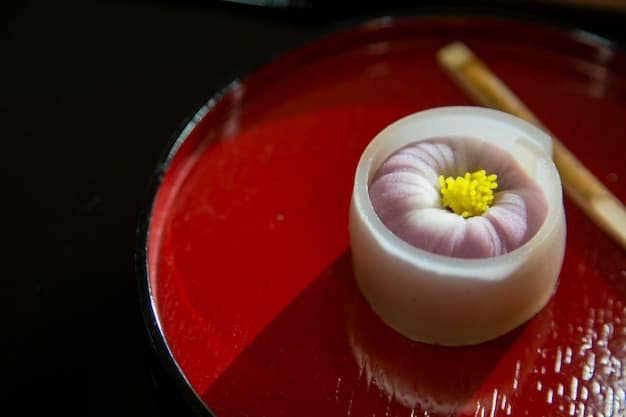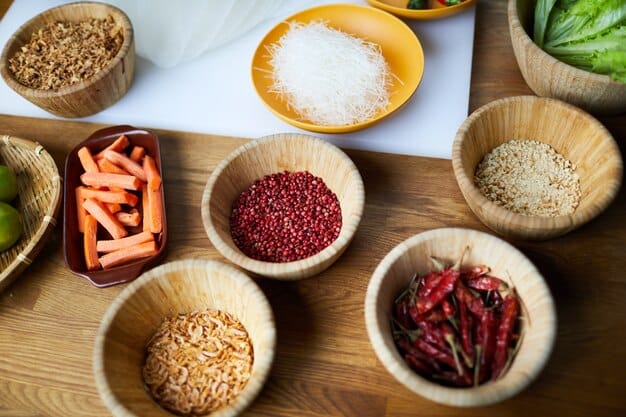Korean Street Food at Home: Easy Recipes for Your Favorite Snacks

Recreate the vibrant flavors of Korean street food in your own kitchen with these easy-to-follow recipes, perfect for satisfying your cravings for authentic Korean snacks.
Craving the delicious and diverse flavors of Korean street food? You don’t need a plane ticket! This guide shows you how to recreate your favorite Korean street food at home: Recreate Your Favorite Snacks with These Easy Recipes.
Unveiling the World of Korean Street Food
Korean street food is more than just a quick bite; it’s a cultural experience. From the bustling markets of Seoul to the quiet corners of Busan, these snacks offer a taste of Korea’s rich culinary heritage. It’s a fun way to connect with K-Culture, offering a vibrant taste adventure.
The Allure of Korean Snacks
Korean street snacks stand out because they’re both delicious and culturally rich. Dishes like spicy tteokbokki and savory Korean pancakes (jeon) deliver distinct tastes. Each bite connects you to Korea’s culinary traditions.
- Variety: Endless options, from savory to sweet.
- Affordability: Budget-friendly treats that are accessible to everyone.
- Experience: A true taste of Korean culture and tradition.
Bringing these flavors home means more than just preparing food; it’s about creating a memorable experience. Whether you’re hosting a K-drama viewing party or simply want to enjoy a taste of Korea, these recipes offer a delicious way to dive into Korean culture.

Top 5 Korean Street Food Recipes to Try at Home
Ready to transform your kitchen into a Korean street food stall? These five recipes are a great starting point, offering a mix of sweet, savory, and spicy flavors that are sure to please your palate. With easy-to-follow instructions, you’ll be enjoying these treats in no time.
1. Tteokbokki (Spicy Rice Cakes)
Tteokbokki is arguably the most popular Korean street food. These chewy rice cakes are simmered in a spicy gochujang-based sauce, creating a fiery and satisfying dish. Perfect for a cold day or when you’re craving something with a kick, here’s how you can bring this classic to your table:
- Ingredients: Rice cakes, gochujang, gochugaru, anchovy broth, green onions, and fish cakes (optional).
- Preparation: Simmer rice cakes in the broth with gochujang and gochugaru until softened and the sauce thickens.
- Serving: Garnish with green onions and sesame seeds. Enjoy hot!
2. Kimchi Jeon (Kimchi Pancake)
Kimchi jeon is a savory pancake made with kimchi, flour, and various vegetables. It’s crispy, flavorful, and a great way to use up leftover kimchi. Making it at home is simple, and it’s a crowd-pleaser at parties.
- Ingredients: Kimchi, flour, water, green onions, and vegetable oil.
- Preparation: Mix ingredients into a batter and pan-fry until golden brown and crispy.
- Serving: Serve with a dipping sauce of soy sauce and vinegar.
These recipes blend classic flavors with home cooking convenience. Each dish provides a unique glimpse into the world of Korean street food, giving you both flavor and cultural insight right in your kitchen.
Essential Ingredients for Korean Street Food
To successfully recreate Korean street food at home, it’s important to stock your pantry with key ingredients. These components form the foundation of many popular dishes, ensuring you can achieve authentic flavors.
Gochujang and Gochugaru: The Dynamic Duo
Gochujang (Korean chili paste) and gochugaru (Korean chili flakes) are essential for adding spice and depth to your dishes. Gochujang provides a fermented, savory heat, while gochugaru offers a brighter, fruitier spiciness.
- Versatility: Used in a wide range of dishes, from tteokbokki to kimchi.
- Flavor Profile: Gochujang adds umami and depth, gochugaru adds vibrant color and heat.
- Availability: Available in most Asian grocery stores and online.
Fish Sauce and Soy Sauce: Umami Boosters
Fish sauce and soy sauce are key umami enhancers. Fish sauce adds a salty, savory depth, while soy sauce provides a more balanced and familiar flavor.
- Usage: Essential for sauces, stews, and marinades.
- Flavor Depth: Enhances the overall taste profile of your dish.
- Alternatives: For vegetarian options, use mushroom-based soy sauce.
Having these basic ingredients on hand will make your Korean cooking adventures much easier and more authentic. They capture the essence of Korean flavors, allowing you to create dishes that are both delicious and true to their roots.

Tips for Mastering Korean Street Food at Home
While having the right ingredients is crucial, mastering the techniques is just as important. Here are some tips to help you elevate your homemade Korean street food to the next level.
Perfecting the Texture
The texture is a key aspect of Korean street food. Whether it’s the chewiness of tteokbokki or the crispiness of kimchi jeon, getting it right can make all the difference.
- Tteokbokki: Soak rice cakes in water before cooking to achieve the perfect chewiness.
- Kimchi Jeon: Use cold water in your batter for a crispier pancake.
- Korean Fried Chicken: Double-fry the chicken for extra crunch.
Balancing Flavors
Korean cuisine is all about balancing flavors – sweet, savory, spicy, and sour. Don’t be afraid to adjust the recipes to suit your taste preferences.
Use a balance of gochujang, soy sauce, and sesame oil to build layered, complex flavors, experiment with different additions like garlic, ginger, and a dash of sugar.
Presentation Matters
Presentation can make a big difference. Garnish your dishes with green onions, sesame seeds, and a drizzle of sesame oil to enhance their appeal.
Plate your food attractively, using colorful dishes. Consider adding a side of kimchi or pickled radish to complete the experience.
By mastering these techniques and paying attention to the small details, you can create Korean street food that’s not only delicious but also visually appealing. Dive in and enjoy your culinary creation.
Adapting Recipes to Your Taste
One of the best parts about cooking at home is the ability to customize recipes to your liking. Korean street food is no exception. Feel free to experiment with different ingredients and flavors to create dishes that perfectly suit your taste.
Spice Level
Korean street food is known for its spiciness, but you can easily adjust the heat level by controlling the amount of gochujang and gochugaru you use.
If you prefer milder dishes, start with a small amount of chili paste and add more to taste. For those who love the heat, don’t be afraid to pile it on! You can also add a pinch of sugar to balance out the spiciness, and adding dairy helps tame the heat too.
Ingredient Substitutions
Don’t have all the ingredients on hand? No problem! There are plenty of substitutions you can make without sacrificing flavor.
Experiment to discover new flavor combinations. If you don’t have Korean rice cakes, try using gnocchi for a similar chewiness. If you don’t have gochugaru on hand, chili powder can be used in its place.
Dietary Needs
Adapting recipes to meet dietary needs is also simple once you get used to Korean cooking. Gluten-free soy sauce can be used in place of regular soy sauce, and vegan fish sauce can be used for an umami flavor booster.
- Vegetarian/Vegan: Use tofu or mushrooms in place of meat. Experiment with vegetable-based broths that add richness to soup and stew bases.
- Gluten-Free: Use gluten-free soy sauce (Tamari) and rice flour. Make sure any noodles you use are rice based.
With a little creativity, you can create Korean street food dishes that are perfect for you and your family. Embrace the flexibility and have fun experimenting in the kitchen!
Exploring Regional Variations
Korean street food is not a monolith, and there are many regional variations to discover. Each region boasts its own unique specialties and twists on classic dishes.
Seoul vs. Busan
Seoul is known for its trendy and innovative street food, while Busan is famous for its seafood-based dishes. Exploring these flavors will give you a fuller picture of the country’s rich culture.
You could make these regional variations, making the flavors of Korea even more accessible!
Jeonju and Gwangju
Jeonju, the food capital of Korea, is famous for its bibimbap and hanjeongsik (Korean full course meal). Gwangju, on the other hand, is known for its spicy and bold flavors.
Consider spicing up your dishes Korean style and experience more of the regional culture.
By exploring these variations, you can expand your street food knowledge and even inspire new creations in your kitchen. Embrace the diversity of Korean cuisine.
| Key Point | Brief Description |
|---|---|
| 🌶️ Tteokbokki | Spicy rice cakes simmered in gochujang sauce, a popular and fiery snack. |
| 🥞 Kimchi Jeon | Savory pancake made with kimchi, offering a crispy and flavorful experience. |
| 🥢 Essential Ingredients | Gochujang, gochugaru, fish sauce, and soy sauce are key to authentic flavors. |
| 👨🍳 Mastering Techniques | Perfecting texture and flavor balance are vital for delicious results. |
Frequently Asked Questions
▼
The main ingredient in Tteokbokki is Garae-tteok, which are long, white cylinder-shaped rice cakes. They provide the dish’s chewy texture and serve as a base to absorb the spicy sauce.
▼
Yes! Overly fermented Kimchi is actually preferred for Kimchi Jeon. The sourness adds a wonderful depth of flavor to the pancake, making it even more delicious.
▼
If you can’t find Gochujang, you can use a mix of red pepper paste and miso paste as a substitute. Add a touch of sugar to mimic the sweetness of Gochujang.
▼
The secret to crispy Korean fried chicken is double-frying. Fry the chicken at a lower temperature first, then fry it again at a higher temperature to achieve that extra crispy exterior.
▼
Essential side dishes include Kimchi, pickled radish, and Korean cucumber salad. These provide a refreshing contrast to the rich and spicy flavors of the main dishes.
Conclusion
Bringing the vibrant world of Korean street food into your home is easier than you might think. With the right ingredients, a little bit of practice, and these easy recipes, you can recreate your favorite snacks and enjoy a taste of Korea anytime. So gather your ingredients, put on some K-pop, and start cooking!





